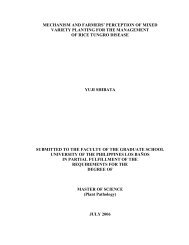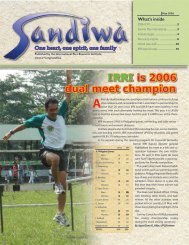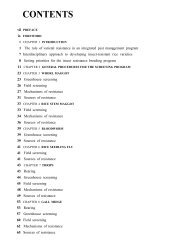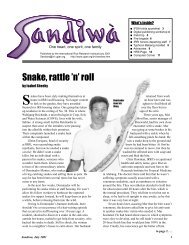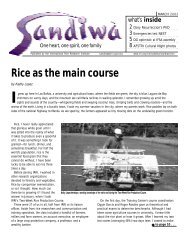Untitled - International Rice Research Institute
Untitled - International Rice Research Institute
Untitled - International Rice Research Institute
You also want an ePaper? Increase the reach of your titles
YUMPU automatically turns print PDFs into web optimized ePapers that Google loves.
Seedborne<br />
inoculum<br />
Reinfection/<br />
infection of seed<br />
Transmission<br />
(Establishment)<br />
Infected<br />
seed<br />
Crop damage/<br />
Injury (Impact)<br />
Inoculum<br />
production<br />
Disease<br />
development<br />
Infection<br />
efficiency<br />
Climatic<br />
conditions<br />
Cropping<br />
environments<br />
Fig. 2. Diseases and infection cycles of a seedborne fungal disease and its effect.<br />
lum for F. moniliforme is important. Once the<br />
seedborne inoculum is minimized, the disease is<br />
likely to be controlled.<br />
Changes in crop cultivation methods and cultural<br />
practices affect seedborne diseases. In traditional<br />
methods of cultivation, rice seedlings are raised in a<br />
seedbed with a saturated water supply. Because of<br />
the reduction in arable land and the decreasing productivity<br />
of available agricultural land, new methods<br />
of cultivation are being developed. These new methods<br />
are conducive to the transmission and development<br />
of seedborne diseases previously considered<br />
minor.<br />
In epidemiological research, seed transmission<br />
and establishment of disease derived from seedborne<br />
inoculum should be considered. These data are essential<br />
for assessing the importance of seedborne<br />
pathogens.<br />
Seed transmission<br />
McGee (1995) indicated that one of the missing links<br />
in seed health testing is the lack of information on<br />
seed transmission. Based on postquarantine planting,<br />
one of the difficulties encountered is distinguishing<br />
between a disease that developed from inoculum<br />
derived from the seed and that from other sources.<br />
Polymerase chain reaction (PCR) DNA technology<br />
is useful in this regard. Based on DNA fingerprinting,<br />
patterns of a pathogen population can be distinguished<br />
from those of the pathogen manifesting a<br />
disease on the crop grown from the seed. This<br />
would establish the transmission of the seedborne<br />
inoculum and its relation to the disease on the crop<br />
in the field. In routine disease monitoring of field<br />
crops such as rice or other nursery crops, identifying<br />
disease foci in nursery beds may be an alternative.<br />
For rice, this appears feasible at the seedling<br />
stage in the seedbed. A disease focus is a patch of<br />
crop with disease limited in space and time<br />
(Zadoks and van den Bosch 1994) and is likely to<br />
have been caused by the initial source of inoculum.<br />
In Japan, the seedbox nursery for rice provides an<br />
ideal means to identify the disease foci of single or<br />
different seedborne pathogens. The paper towel<br />
method, a very common method for testing seed<br />
germination, resulted in more seedling mortality<br />
and thus less germination than the seedbed method<br />
(seedbed with field soil) used in crop production<br />
(Table 4). The method used for assessing the effect<br />
of seedborne fungal pathogens on seed germination<br />
varies.<br />
8



